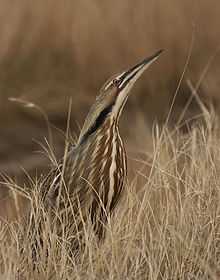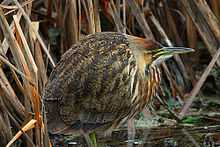American bittern
| American bittern | |
|---|---|
| | |
| Conservation status | |
| Scientific classification | |
| Kingdom: | Animalia |
| Phylum: | Chordata |
| Class: | Aves |
| Order: | Pelecaniformes |
| Family: | Ardeidae |
| Genus: | Botaurus |
| Species: | B. lentiginosus |
| Binomial name | |
| Botaurus lentiginosus (Rackett, 1813) | |
 | |
| Range of B. lentiginosus Breeding range Year-round range Wintering range | |
| Synonyms | |
|
Palaeophoyx columbiana McCoy, 1963 | |
The American bittern (Botaurus lentiginosus[2]) is a wading bird of the heron family (Ardeidae).
Description


It is a large, chunky, brown bird, very similar to the Eurasian great bittern (Botaurus stellaris), though slightly smaller. It is 58–85 cm (23–33 in) in length, with a 92–115 cm (36–45 in) wingspan and a body mass of 370–1,072 g (0.816–2.363 lb).[3][4]
Although common in much of its range, the American bittern is usually well-hidden in bogs, marshes and wet meadows. Usually solitary, it walks stealthily among cattails or bulrushes. If it senses that it has been seen, the American bittern becomes motionless, with its bill pointed upward, causing it to blend into the reeds. It is most active at dusk. More often heard than seen, this bittern has a call that resembles a congested pump.
The exact mechanic the bittern uses to make its distinctive song is not fully understood. It has been suggested that the bird gradually puffs out its neck by inflating its oesophagus with air accompanied by a mild clicking or hiccuping sound. The oesophagus is kept inflated by means of flaps aside the tongue. Once this action is completed and the oesophagus is fully inflated, the distinctive gulping sound is made in the syrinx. Once the song is complete the bird deflates its oesophagus.[5]
Like other members of the heron family, the American bittern feeds in marshes and shallow ponds, dining on amphibians, fish, insects and reptiles.
This bittern winters in the southern United States and Central America. It summers throughout Canada and much of the US. As a long-distance migrant, it is a very rare vagrant in Europe, including Great Britain and Ireland. This bird nests in isolated places with the female building the nest and the male guarding it. Two or three eggs are incubated by the female for 29 days, and the chicks leave after 6–7 weeks.
No subspecies are accepted today. However, fossils found in the Ichetucknee River, Florida, and originally described as a new form of heron (Palaeophoyx columbiana; McCoy, 1963)[6] were later recognized to be a smaller, prehistoric subspecies of the American bittern which lived during the Late Pleistocene (Olson, 1974)[7] and would thus be called B. l. columbianus.
This bird's numbers are declining in many parts of its range due to habitat loss.
Many of the folk names are given for its distinctive call;[8] E. Choate lists "bogbumper" and "stake driver".[9] Pliny likened the old-world bittern's call to the roaring of a bull, "boatum tauri", whence the generic name Botaurus.
To the Cajuns of South Louisiana this bird was known as a "grobek" (from French gros bec - "large beak"), and was previously hunted for food, being considered a delicacy.
Protected status
The American bittern (Botaurus lentiginosus) is protected under the United States Migratory Bird Treaty Act of 1918.[10] It is also protected under the Canadian Migratory Birds Convention Act of 1994.
References and notes
- ↑ BirdLife International (2012). "Botaurus lentiginosus". IUCN Red List of Threatened Species. Version 2013.2. International Union for Conservation of Nature. Retrieved 26 November 2013.
- ↑ Botaurus: Latin for "bittern"; lentiginosus: Latin for "freckled", in reference to its plumage.
- ↑ American Bittern. Cornell Lab of Ornithology. All About Birds
- ↑ CRC Handbook of Avian Body Masses by John B. Dunning Jr. (Editor). CRC Press (1992), ISBN 978-0-8493-4258-5.
- ↑ The Function of the Oesophagus in the Bittern's Booming. The Auk April 1, 1922
- ↑ McCoy, John J. (1963). "The fossil avifauna of Itchtucknee River, Florida". Auk 80 (3): 335–351. doi:10.2307/4082892.
- ↑ Olson, Storrs L. (1974). "A reappraisal of the fossil heron Palaeophoyx columbiana McCoy". Auk 91 (1): 179–180. doi:10.2307/4084689.
- ↑ McAtee, Waldo Lee (1959). Folk-names of Canadian Birds. Bulletin of National Museum of Canada 51. National Museum of Canada. p. 6.
- ↑ Dictionary of American Bird Names (revised ed. Harvard Common Press 1985)
- ↑ List of Migratory Bird Species Protected by the MiGratory Bird Treaty Act as of December 2, 2013
Further reading
- National Geographic Society (2002). Field Guide to the Birds of North America. National Geographic, Washington DC. ISBN 0-7922-6877-6
External links
| Wikimedia Commons has media related to American bittern. |
| Wikispecies has information related to: Botaurus lentiginosus |
- American Bittern – Cornell Lab of Ornithology
- American bittern - Botaurus lentiginosus - USGS Patuxent Bird Identification InfoCenter
- American Bittern Botaurus lentiginosus - ENature.com
- North American Bittern videos, photos, and sounds at the Internet Bird Collection
- American Bittern photo gallery at VIREO (Drexel University)
